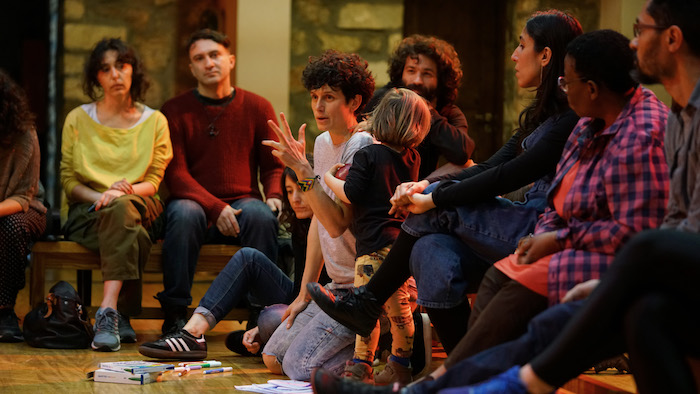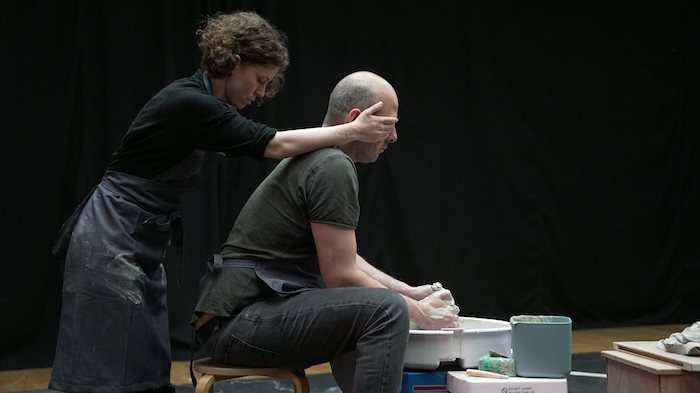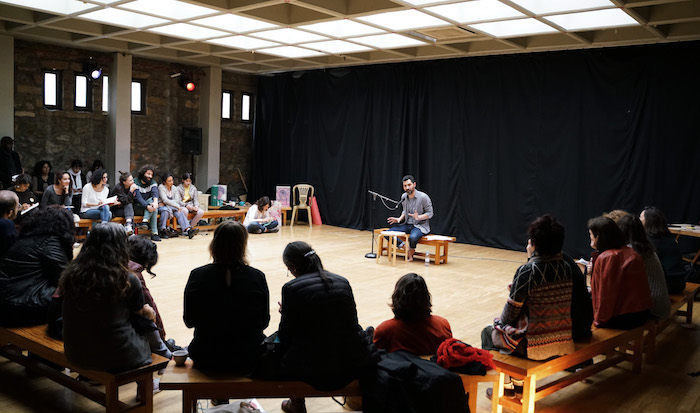ZOOM IN!

EDN Atelier on Dance & Craft, Athens 2019
Zoom in means sensing the world through the minor and listening to the delicate resonances.
During two days artists, curators, dramaturges, cultural professionals, skilled workers and pedagogues from Greece, Spain, Switzerland, France, Belgium, England and Austria gathered at the Duncan Dance Research Centre in Athens to zoom in together, to exchange and thus produce knowledge. The atelier included working sessions, installations, collective and physical activities, conversations and lecture performances. At its heart was the fallowing question: How the relation between art and craft can challenge, redirect and nourish artistic, curatorial, pedagogical and social practices? The various artistic, personal and cultural backgrounds of the participants allowed shedding light on these topics from diverse perspectives.

During two days we looked at craft and art practices as something united and in dialogue with everyday life. The focus was the human and its creative power. We looked at how creativity is expressed in art and through craftsmanship. Rather than comparing the latter, the aim was to observe and explore the relation between them. Six craftsmen/artists and performing artists coupled up for several weeks to dive into a collaborative research process to afterwards share their diverse outcomes during the two days atelier with the participants. I am going to provide a closer insight into three inputs that drew my interest. The ceramist Theodora Chorafa and the performer Anna Tzakou experienced the value of the aimless action, which challenged their individual identities as creators. They had to let go part of their perfectionism and familiarity in order to find new collaboration ways. The clay was treated as the connecting physical material between them. What was fascinating to me was how the notion of form in both dance and ceramics was transformed. In groups of 20 people the atelier guests could experiment with the clay and observe its effect on the body and movement. Both Anna and Theodora verbally instructed the group. Such an experiment immediately brings together an international group and flattens the hierarchies, which are usually very present during meetings, where leaders from institutions, directors and artists meet.
The lecture performance by the Catalan choreographer Salva Sanchis was thought provoking and was a great example how to present an elaboration between practice and theory. In his theoretical lecture Salva interwove topics such as ‘neoliberalism’, ‘the culture of polarizing’, ‘the necessity of expression’ and drew from his experience as a teacher, dancer and choreographer who crafts with the body. He mentioned the fragility and strength of choreographic work that hold together and transmit solely through being well crafted and presented. By that he means the genre of contemporary dance performance that is constituted physically in time and space and not around a specific subject. I find this a significant point in relation to craftsmanship in dance and choreography. From my perspective, if well crafted, the art form of dance has the ability to reflect on the ever-changing social and political landscape without labeling itself with ‘trendy topics’. To me it is less what the material is about but more what the material is doing.
Moïs Touré, a theatre director from France provoked with the fallowing statement: With emotions and concepts art is created and with material crafts are created. Where lies dance? If we look at the body as a material to craft dance and the mind to develop concepts and the emotional source to convey content then a dance performance is art and craft at the same time. Where to draw the line between art and craft and why do we distinct them? Is art something more sophisticated than craft?

The aim of this two-day atelier was, as Penelope Iliasko mentioned, to plant a seed, which will sprout later in diverse cities. This open and honest human and artistic exchange was only possible because there was an atmosphere of generosity and curiosity. I met Dr. Guy Cools whilst forming shapes with a piece of clay and this is a very different way of human encounter than sitting at a table with bottled water introducing yourself and exchanging CVs. To sum up: Non-hierarchical meetings with tangible content create a humble and productive working atmosphere, which cultivate a generous thinking and research space. Such professional platforms are a necessity to collectively remind us about the very essence of what art, craftsmanship and dance are, in fact to express humanity. It is refreshing and crucial to get in touch with artists from other disciplines and to consider creativity in a holistic way. As a performing artist I believe it is very nourishing to have from time to time working settings in the form of a lab or a residency to investigate into ‘non product’ oriented research, which evokes questions and becomes stimulating. Different than when I attend a dance workshop and I clearly experience myself as a contemporary dancer I perceived myself during the atelier in Athens simply as creative and curious person. On one hand the artistic background of each of us mattered, as thus a rich contribution was constituted, on the other hand it did not matter at all. This contradiction was valid.
I would like to create a similar platform of exchange in Bern at Dampfzentrale in form of a lab, where Bern based and international artists investigate together and share their outcomes.

Credits
Fotocredits: Alekos Bourelias, Christos Bourelias, Matina Psarraki.
